| |
Pegylated interferon alfa and ribavirin for 14 versus 24 weeks in patients with hepatitis C virus genotype 2 or 3 and rapid virological response
|
| |
| |
Hepatology Nov 2007
Olav Dalgard 1 2 *, Kristian Bjoro 3, Helmer Ring-Larsen 4 5, Einar Bjornsson 6, Mona Holberg-Petersen 7, Eva Skovlund 8, Olle Reichard 9, Bjorn Myrvang 1, Bo Sundelof 10, Stale Ritland 11, Kjell Hellum 12, Aril Fryden 13, Jon Florholmen 14, Hans Verbaan 15, North-C Group
1Infectious Disease Department, Ulleval University Hospital, Oslo, Norway
2Medical Department, Aker University Hospital, Oslo, Norway
3Medical Department, Rikshospitalet, Oslo, Norway
4Liver Unit, Rigshospitalet, Copenhagen, Denmark
5Faculty of Pharmacology and Pharmacotherapy, University of Copenhagen, Copenhagen, Denmark
6Department of Internal Medicine, Sahlgrenska University Hospital, Goteborg, Sweden
7Department of Microbiology, Ulleval University Hospital, Oslo, Norway
8School of Pharmacy, University of Oslo, Oslo, Norway
9Karolinska University Hospital, Stockholm, Sweden
10Medical Department, Gavle Hospital, Gavle, Sweden
11Medical Department, Buskerud University Hospital, Drammen, Norway
12Medical Department, Akershus University Hospital, Nordbyhagen, Norway
13Linkoping Hospital, Linkoping, Sweden
14Medical Department, Tromso University Hospital, Tromso, Norway
15Medical Department, Malmo University Hospital, Malmo, Sweden
Funded by:
Schering-Plough
Abstract
A recent nonrandomized pilot trial showed that hepatitis C virus (HCV) patients with genotype 2/3 and rapid virological response (RVR) had a 90% sustained virological response (SVR) rate after 14 weeks of treatment. We aimed to assess this concept in a randomized controlled trial. In the trial, 428 treatment-naive HCV RNA-positive patients with genotype 2 or 3 were enrolled. Patients with RVR were randomized to 14 (group A) or 24 (group B) weeks of treatment. Patients were treated with pegylated interferon -2b (1.5 g/kg) subcutaneously weekly and ribavirin (800-1400 mg) orally daily. The noninferiority margin was set to be 10% between the two groups with a one-sided 2.5% significance level. RVR was obtained in 302 of 428 (71%), and 298 of these were randomized to group A (n = 148) or group B (n = 150). In the intention-to-treat analysis, SVR rates were 120 of 148 (81.1%) in group A and 136 of 150 (90.7%) in group B (difference, 9.6%; 95% confidence interval, 1.7-17.7). Among patients with an HCV RNA test 24 weeks after the end of treatment, 120 of 139 (86.3%) patients in group A achieved SVR compared with 136 of 146 (93.2%) in group B (difference, 6.9%; 95% confidence interval, -0.1 to +13.9). Conclusion: We cannot formally claim that 14 weeks of treatment is noninferior to 24 weeks of treatment. However, the SVR rate after 14 weeks of treatment is high, and although longer treatment may give slightly better SVR, we believe economical savings and fewer side effects make it rational to treat patients with genotype 2 or 3 and RVR for only 14 weeks.
Approximately 55% of patients with chronic hepatitis C obtain a sustained virological response (SVR) after treatment with pegylated interferon alfa (PEG-IFN-a) and ribavirin.[1][2] However, only a minority of those in need of therapy actually receive treatment,[3] primarily because of high medical costs and frequent and sometimes serious side effects. Thus, finding the appropriate treatment schedule for each chronic hepatitis C patient is important.
Several factors have an impact on response to treatment, with hepatitis C virus (HCV) genotype being the single most important predictor of response. Those with genotype 1 infection have an SVR rate of 40% to 55% versus 70% to 90% among those with genotype 2 or 3 infection.[1][2] HCV genotype has also been shown to be the best parameter on which to base individualization of therapy. In patients with genotype 1, higher SVR rates are obtained with 48 weeks than with 24 weeks of treatment. In contrast, no substantial gain in response rates is achieved by the prolongation of therapy beyond 24 weeks in patients with genotypes 2 or 3.[4][5]
The results of a large, multicenter, United States-based trial (ACCELERATE) showed that reducing the duration of therapy from 24 to 16 weeks in patients with genotype 2/3 lessened the chance of SVR.[6] However, there was a large subgroup of genotype 2/3 patients in that study who achieved SVR after 16 weeks of treatment. Early viral kinetics could help identify patients who are appropriate for shorter treatment. Viral loads decline rapidly in almost all genotype 2/3 patients within the first 24 hours after interferon alfa administration.[7][8] Patients who continue to experience a sharp decline in viral load during the first 4 to 12 weeks of treatment have a greater chance of achieving SVR than those who experience a less rapid decline or no decline at all.[8-10] Pilot studies have suggested that treatment can be reduced from 24 to between 12 and 16 weeks without treatment outcomes being sacrificed in genotype 2/3 patients who achieve a rapid virological response (RVR; undetectable HCV RNA at week 4 of therapy).[11-13] We have demonstrated a 90% SVR rate following 14 weeks of treatment with PEG-IFN-a-2b and ribavirin in genotype 2/3 patients with RVR.[11] However, this was a nonrandomized and uncontrolled study. The aim of the current trial was to confirm the results of our previous study in a large, randomized, controlled trial.
Patients and Methods
Patient Selection.
A total of 428 treatment-naive, HCV RNA-positive patients with HCV genotype 2 or 3 were enrolled in this randomized, controlled, open-labeled, noninferiority trial. Patients were recruited from 49 hospitals in Denmark, Sweden, and Norway between March 2004 and September 2005. Patients were eligible for inclusion if they were HCV RNA-positive, had HCV genotype 2 or 3, had elevated alanine aminotransferase (ALT) levels at least once during the 6 months prior to study entry, and were treatment-naive. Patients were excluded if they were known to have injected drugs or abused alcohol within the 6 months prior to study entry; had poorly controlled psychiatric illnesses; had decompensated cirrhosis; were hepatitis B surface antigen-positive or anti-human immunodeficiency virus-positive; or suffered from other relevant concurrent medical conditions, including chronic liver diseases of etiologies other than HCV infection. Liver biopsy was not required. The study was approved by each country's regional ethics committees, and all patients provided written, informed consent.
Study Design.
All patients were treated with PEG-IFN-a-2b (PegIntron, Schering-Plough, Kenilworth, NJ) at a dosage of 1.5 g/kg subcutaneously once weekly and ribavirin (Rebetol, Schering-Plough) at a dosage of 800 to 1400 mg/day based on body weight (<65 kg, 800 mg/day; 65-85 kg, 1000 mg/day; 86-105 kg, 1200 mg/day; and >105 kg, 1400 mg/day). Patients with RVR, defined as HCV RNA levels of <50 IU/mL after 4 weeks (day 27) of treatment, were randomized to 14 (group A) or 24 (group B) weeks of treatment. The patients were not blinded for the results of HCV RNA testing. At week 8, they were informed of week 4 results and told to which group they were randomized. Patients without RVR were treated for 24 weeks (group C; Fig. 1). Patients with no HCV RNA test performed between day 22 and day 32 were also allocated to group C.
Virology.
Qualitative HCV RNA analysis was performed with the COBAS AmpliPrep/COBAS AMPLICOR HCV test, version 2.0 (lower detection level, 50 IU/mL; Roche, Branchburg, NJ). Viral load was measured with the COBAS AmpliPrep/COBAS TaqMan HCV test (the lower limit of detection is 15 IU/mL, and the linear range of the assay is from 43 to 6.90 X 107 IU/mL; Roche). All quantifications were performed at one laboratory with ethylene diamine tetraacetic acid-plasma, which had been stored at -70 C. Viral genotype was determined locally with a hybridization technique [VERSANT HCV genotype assay (LiPA), Bayer HealthCare LLC, Tarrytown, NY].
Qualitative HCV RNA analyses were performed at week 4, at the end of treatment (week 14 or 24), and 24 weeks after the end of treatment (week 38 or 48). Quantitative HCV RNA analysis was performed once before the start of treatment.
Assessments.
The primary efficacy endpoint was SVR, which was defined as undetectable plasma HCV RNA (<50 IU/mL) at 24 weeks post-treatment and was evaluated according to an intention-to-treat analysis and an analysis of those with an available HCV RNA analysis 24 weeks after the end of treatment. In the intention-to-treat analysis, all patients who received at least one dose of medication were included, and patients without SVR and patients who were lost to follow-up were recorded as nonresponders.
Liver fibrosis was assessed with the aspartate aminotransferase-to-platelet ratio index (APRI) score [aspartate aminotransferase (AST) per ASTupper normal level per plateletlower normal level: <2 = early stage disease and >2 = bridging fibrosis or cirrhosis].[14]
Safety was evaluated with patient-reported adverse events, which were rated on a scale from 0 to 4 (0 = no adverse event and 4 = grave adverse event), laboratory tests (blood chemistry and hematology), and vital signs (blood pressure, pulse, and temperature).
Objectives and Hypothesis.
The following hypothesis was tested: in patients with HCV genotype 2 or 3 who attain RVR, 14 weeks of treatment with PEG-IFN-a-2b (1.5 g/kg subcutaneously once weekly) and ribavirin (800-1400 mg/day) is noninferior to 24 weeks of treatment. Furthermore, we tested the hypothesis that there are fewer side effects with 14 versus 24 weeks of treatment.
Sample Size.
The noninferiority margin was set at 10% between the two groups. To obtain 80% statistical power with a 1-sided 2.5% significance level, approximately 150 patients per treatment group were necessary. Initial enrollment plans included 400 patients to ensure randomization of 300; however, because RVR rates were lower than expected, an amendment to the protocol was made (May 2005), increasing the number of enrolled patients to 435.
Statistical Analysis.
The proportion of the intention-to-treat population and the population with an available HCV RNA test at 24 weeks of follow-up that achieved SVR was calculated for groups A and B, and the associated 95% confidence interval (CI) for the differences was estimated. Noninferiority of 14 weeks of treatment to 24 weeks of treatment would be accepted if the upper bound of the 95% CI around the difference in the SVR rate was below the noninferiority margin (10%).
The analysis was conducted with the SPSS version 14.0 software package.
Proportions were compared between groups by Pearson's chi-square test. Logistic regression analyses were performed with SVR and RVR as dependent variables and with genotype, viral load, sex, age, weight, and baseline ALT and RVR as independent variables. A two-tailed P value < 0.05 was considered significant.
Results
RVR.
The median age of the enrolled population of 428 patients was 40 years, 65% were men, and 80% were infected with genotype 3 (Table 1). Of the 428 enrolled patients, 302 (70.6%) achieved RVR. Four patients with RVR stopped treatment at week 4 and were not randomized (Fig. 1), and 298 were randomized to either group A (n = 148) or group B (n = 150).
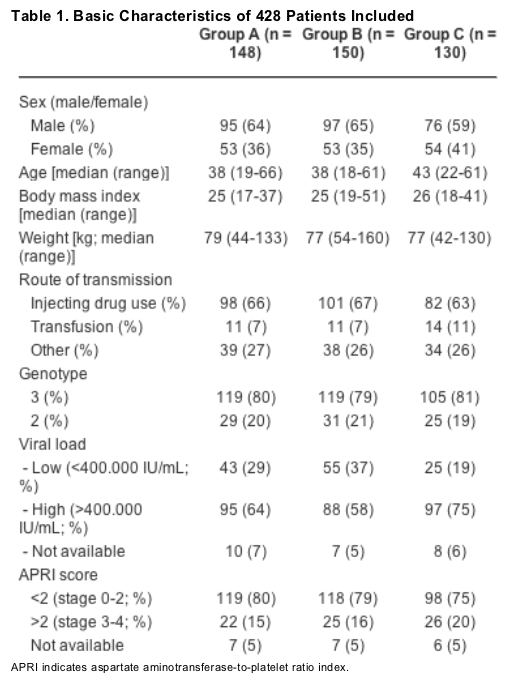
Predictors of RVR.
Predictors of RVR were identified by logistic regression analysis. Factors entered into the analysis were age (40 versus >40 years), gender (male versus female), viral load (400,000 IU/mL), genotype (2 versus 3), weight (70 kg), and pretreatment ALT levels (3 times upper normal level). Independent predictors of RVR were male gender, low viral load, and age
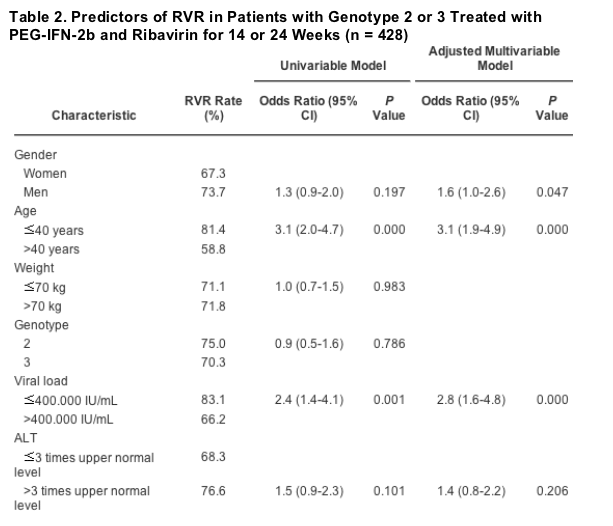
SVR.
According to the intention-to-treat analysis, the end-of-treatment response was 91.9% (136 of 148) in group A and 96.0% (144 of 150) in group B, and relapse rates were 10.8% (16 of 148) and 5.3% (8 of 150) in groups A and B, respectively. SVR rates were 81.1% (120 of 148 patients) in group A and 90.7% (136 of 150 patients) in group B, representing a difference of 9.6% (95% CI, 1.7-17.7).
In group A, 6.1% (9 of 148) were lost to follow-up and considered to be treatment failures in the intention-to-treat analysis versus 2.7% (4 of 150) in group B (Fig. 1). All patients lost to follow-up in groups A and B were on-treatment responders.
Among patients with an available HCV RNA test 24 weeks after the end of treatment, 120 of 139 (86.3%) patients in group A achieved SVR versus 136 of 146 (93.2%) in group B; this represented a difference of 6.9% (95% CI, -0.1 to +13.9). The relapse rates in patients with RVR randomized to 14 weeks according to gender, age, genotype, viral load, and treatment adhesion are presented in Table 3.
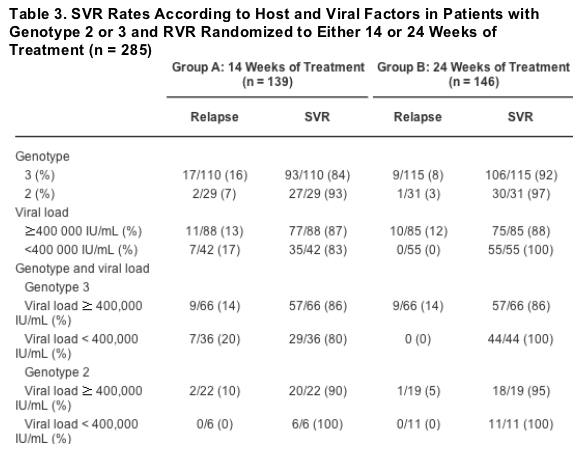
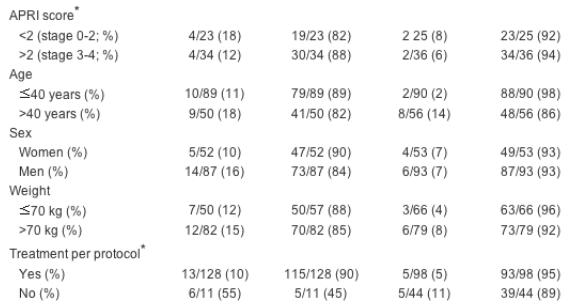
Thirteen patients lost to follow-up are not included. APRI indicates aspartate aminotransferase-to-platelet ratio index; RVR, rapid virological response; and SVR, sustained virological response.
*Treatment per protocol is defined as receiving more than 80% of the planned doses of both drugs for more than 80% of the planned time (group A, more than 11 weeks; group B, more than 19 weeks).
Comparing only those patients who took 100% of the planned dose of both drugs for the planned number of weeks (14 or 24 weeks)and who had an available HCV RNA test 24 weeks after the end of treatment, we found that SVR rates were 105 of 116 (90.5%) in group A and 80 of 85 (94.1%) in group B. In patients with RVR who received between 4 and 10 injections of PEG-IFN-a-2b, the SVR rate was 5 of 11 (46%) versus 132 of 148 (89.0%) and 115 of 122 (94.0%) for those who received 11-16 and 16-24 injections, respectively.
Responses in patients randomized to group A or B according to patient and viral characteristics are presented in Table 3. Comparing the effect of prolonged treatment between subgroups of each potential prognostic factor by interaction tests, we found no significant interaction.
Adverse Events.
Adverse events were more common in group B than group A at weeks 18 and 24 after initiation of treatment (data not shown); however, the incidence of adverse events did not differ significantly between the groups as anemia (hemoglobin < 10 g/dL) occurred in 9 of 148 (6.1%) and 13 of 150 (8.7%; P = 0.39), neutropenia (neutrophils < 0.7 109/L) occurred in 9 of 148 (6.1%) and 15 of 149 (10.1%; P = 0.21), thyroid disturbances (thyroid stimulating hormone < 0.02 MIU/L or > 4.5 MIU/L) occurred in 10 of 130 (7.7%) and 12 of 128 (9.4%; P = 0.63), and depression occurred in 29 of 110 (26.4%) and 37 of 124 (29.8%; P = 0.56) in groups A and B, respectively.
Premature treatment discontinuation (defined as receiving less than 80% of prescribed injections) occurred in 9 of 148 (6%) patients in group A and 32 of 150 (21%) patients in group B (9 patients in group B discontinued treatment before week 11). Reasons for discontinuation were depression in 2 and 5, fatigue in 1 and 11, thyroid disorders in 0 and 1, skin or hair problems in 2 and 4, drug use in 2 and 1, other complaints in 0 and 3, and undetermined in 2 and 7 in groups A and B, respectively.
Two patients died of a heroin overdose, one at week 4 during treatment and one 18 weeks after the end of treatment. Neither of the patients was diagnosed with depression before overdosing, and the events were felt to be unrelated to the study treatment.
Group C.
After 4 weeks, 126 of 428 (29.4%) patients had detectable HCV RNA. These patients were not randomized; they were allocated to 24 weeks of combination treatment (group C). SVR rates for group C were 54.8% (69 of 126) and 58.5% (69 of 118) among the intention-to-treat population and those with a follow-up HCV RNA test, respectively. SVR rates among those with follow-up data 24 weeks after treatment according to genotype, baseline viral load, and disease status were as follows: 75.0% (15 of 20) and 56.3% (54 of 96) for genotype 2 and 3 patients (P = 0.12); 65% (13 of 20) and 59.6% (53 of 89) for patients with pretreatment viral loads of 400,000 IU/mL (P = 0.65); 65.6% (59 of 90) and 34.8% (8 of 23) for patients with early-stage and late-stage disease according to APRI score (P = 0.007); and 61.0% (25 of 41) and 58.7% (44/75) for patients 40 and >40 years of age (P = 0.81).
SVR in the Total Study Population.
SVR was obtained in 326 of 428 (76.2%) of the total intention-to-treat population and in 326 of 403 (80.9%) of those with 24-week follow-up data. Baseline and on-treatment predictors of SVR were identified by univariate and multivariate logistic regression analyses. Factors entered into the regression analysis were age (40 years), gender (male versus female), viral load (400,000 IU/mL), genotype (2 versus 3), weight (70 kg), ALT level before treatment (3 times upper normal), and RVR (yes versus no). Independent predictors of SVR were RVR (odds ratio, 4.2; 95% CI, 2.4-7.6), genotype 2 (odds ratio, 2.4; 95% CI, 1.1-5.5), and age less than 40 years (odds ratio, 2.0; 95% CI, 1.1-3.5).
Costs.
The mean weekly dose of PEG-IFN-a-2b administered in this study was 110 g, and the mean daily dose of ribavirin was 1000 mg. Currently, 1.5 g/kg PEG-IFN-a-2b and 800 mg of ribavirin daily for 24 weeks is recommended for genotype 2 or 3 patients. On the basis of current prices in the United States, spending on medication for 24 weeks of combination treatment (low-dose ribavirin) is $18,480 (US dollars), and that for 14 weeks of treatment is $11,860 (US dollars). If we consider retreatment for 24 weeks of the 10% of patients with RVR who relapse after 14 weeks of treatment, the mean cost of treating genotype 2/3 patients with RVR would be $13,710 (US dollars; Fig. 2). Thus, provided that all relapsers after 14 weeks of treatment receive retreatment for 24 weeks, the mean saving per patient with this concept versus 24 weeks to all would be $4,770 (US dollars; 26%). Treating for 14 weeks those with RVR and retreating those who relapse is in economical terms rational as long as the relapse rate is less than 35% (calculation not shown).
Figure 2. The cost of treating all patients with HCV genotype 2 or 3 and RVR for 24 weeks, for 14 weeks, or for 14 weeks followed by 24 weeks of retreatment of the 10% who relapse after receiving treatment per protocol (open bars, price per patient; black bars, price per case with SVR).
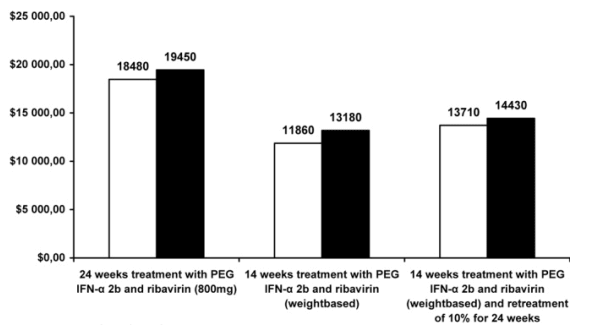
Discussion
In this randomized, controlled, noninferiority trial of 14 versus 24 weeks of combination treatment with PEG-IFN -2b and weight-based ribavirin in patients with genotype 2 or 3 infection and an RVR, a difference in SVR rates between the two arms of 10% was determined. As the 95% CI overlapped the predefined noninferiority margin of 10%, we cannot formally claim that 14 weeks of treatment with PEG-IFN a-2b and ribavirin is noninferior to 24 weeks of treatment.
In a noninferiority trial, the role of the intention-to-treat population should be considered carefully. In our intention-to-treat analyses, patients lost to follow-up were regarded as not achieving SVR. Because the virological relapse rate was low in both groups, this is likely not true for most of these patients. Therefore, we regard the analysis of those not lost to follow-up as more informative from a clinical point of view. Among these patients, the difference in SVR rates was 7%.
Overall, our results are in agreement with those from an Italian randomized, controlled trial comparing 12 weeks of treatment with 24 weeks of treatment among patients with genotype 2 or 3 and RVR [undetectable (<50 IU/mL) HCV RNA at week 4], where a 6% difference favoring 24 weeks of treatment was reported.[12] However, only 45 patients with RVR were treated for 24 weeks, and only 10 of these were genotype 3. A German trial prospectively explored the effect of a shorter (16 weeks) treatment duration in patients with genotype 2 or 3 and RVR.[13] However, comparisons are difficult because RVR was defined in this trial as week 4 HCV RNA levels of <800 IU/mL, as opposed to levels of <50 IU/mL, which were used in the Italian trial and our current study. Lastly, in a subanalysis of the ACCELERATE trial involving 871 patients with genotype 2 or 3 and RVR [undetectable HCV RNA (<50 IU/mL) at week 4] treated for 16 or 24 weeks, an 8% difference in SVR rates between the two treatment groups was reported.[15]
The 86% SVR rate observed among those with an available HCV RNA test at 24 weeks of follow-up observed in the 14-week treatment group is in agreement with our previously published nonrandomized pilot trial.[11] There, 95 patients with genotype 2 or 3 and an RVR were treated for 14 weeks, and 91% obtained an SVR. In comparison, 85% of those treated for 12 weeks in the Italian trial obtained an SVR,[12] and in the subanalysis of the ACCELERATE trial, 82% of patients with an RVR treated for 16 weeks obtained an SVR.[15]
In the 24-week treatment arm, we observed SVR in 93% among those with RVR, whereas Mangia et al.[12] reported SVR in 91% and Shiffman et al.[15] reported SVR in 90% of these patients.
In the present trial, a rather large proportion of patients randomized to 24 weeks of treatment chose to stop treatment earlier than planned. This was possibly due to the patients' and treating physicians' awareness of the excellent SVR rate obtained after 14 weeks of treatment in the pilot trial and may have led to an underestimation of the SVR rate in the 24-week treatment arm.
The choice of the noninferiority margin is important and almost always debatable. In the current study, it was done by clinical judgment by the clinicians who were to include patients in the trial and was chosen to be 10%. It may be argued that a 10% margin is conservative as patients with relapse after a short treatment may expect a high SVR following 24 weeks of retreatment. After agreement on our protocol, this was confirmed by Mangia et al.,[12] who reported that 9 of 10 relapsers after 12 weeks of therapy obtained SVR after a second treatment trial for 24 weeks.
The incidence of side effects did not differ between the two groups. However, the duration of side effect corresponded to the duration of treatment and was much shorter in the short treatment arm.
We chose to reduce treatment duration only in those who achieved an RVR. This was based on our experience from a pilot trial in which patients without RVR had a much lower SVR rate than those with RVR (90% versus 56% in the RVR and non-RVR groups, respectively).[11] It was recently shown by the Shiffman trial that uncritical shortening of the treatment duration to less than 24 weeks in all genotype 2/3 patients is not to be recommended.[6] In this large trial (n = 1462), patients were randomized regardless of week 4 response, and 16 weeks of treatment was clearly shown to be inferior to 24 weeks.
Transmission through injecting drug use is by far the most common way of acquiring HCV infection in the Nordic countries (and in several other countries). Abstinence for 6 months was required to be included in this trial. Despite this, two patients died of overdose during the trial, reflecting that active drug use did occur in this population. Extending these results to a non-drug-using population should therefore be done with caution.
Previous trials have suggested that patients with genotype 3 and a high viral load are more difficult to treat and may be in need of prolonged therapy.[5][11] The poorer response in these patients is confirmed by the present trial. However, if RVR is obtained, we have also been able to show that little is gained by the prolongation of therapy beyond 14 weeks.
Age was strikingly and inversely associated with SVR in the total population. In fact, an almost 10% decrease in the SVR rate with each 10-year increase in age between 30 and 50 years was observed. However, as with genotype and viral load, in those with RVR, no increase in SVR was obtained by the prolongation of therapy. Age could be a confounder for stage of liver disease, but this could not be assessed in this trial as liver biopsies were not required.
Shorter treatment reduces the economical costs for both the patient and society. Treatment for 14 weeks instead of 24 weeks leads to a 26% reduction in drug exposure and a reduction in cost, even when 24 weeks of retreatment of the 10% who relapse after achieving end-of-treatment response is included. In this calculation, costs for consultations, blood tests, and sick leave are not included. Therefore, the real savings of shortening the treatment would be even larger.
In conclusion, the 95% CI of the difference in SVR did overlap the noninferiority margin of 10%. We can therefore not formally claim that 14 weeks of treatment is noninferior to 24 weeks of treatment. However, the SVR rate after 14 weeks of treatment is high, and although longer treatment may give slightly better SVR rate, we believe considerable economical savings, good response to retreatment, and fewer side effects make it rational to treat patients with genotype 2 or 3 and RVR for only 14 weeks.
|
|
| |
| |
|
|
|